The European Beech Annual Tree Ring Widths Time Series, Solar–Climatic Relationships and Solar Dynamo Regime Changes
Abstract
1. Introduction
- The tree rings widths (Dm) time series investigation of a long lived (age 209 ± 1 years; logged in 1983 AD) beech sample (Fagus sylvatica), in the aspect of “Sun–climate” relationship and solar dynamo regime changes during the interval 18th–21st centuries is the first aim of this paper. A specific moment is to search for a possible reaction of ‘Dm’ in transition epochs preceding and during the grand solar minima of Dalton and Gleissberg.
- The second aim is the climate changes (precipitations and/or temperatures for the vegetation season) reconstruction test during the calendar interval 1780–1900 AD.
- On the basis of the obtained ‘1’ statistically significant cycles, a kinematic regression model is built for ‘Dm’ regarding the epoch 1780–1982. It is extrapolated for the next 30 years (1982–2012 AD). The extrapolated data for comparison with the real solar activity and regional climate changes are used (“epignosis test”). It helps for the estimation of how the obtained kinematic model is adequate and stable in time. If the epignose test is successful, the above described steps could be used for extrapolation (as turned out to be in realities). The above described procedure (‘1–3’) for an future calendar interval after 2012 AD on the basis of other beech sample data could be used.
- Another long-lived beech sample (age 245 ± 5years; logged in 2012 AD) time series is used for an additional analysis. The used calendar range of this sample is 1811–2011 AD. The kinematic model extrapolation calendar range is 2012–2045 AD.
2. Data
2.1. Tree Samples
2.2. Instrumental Climatic Data
2.3. Preliminary Data Processing and General Trends. The ~200 Year Cycle in the Longest Beech Tree Ring Widths Data Series
2.4. Two Stage Tree Samples Selection Procedure
- In their T–R spectra, the solar modulated 20–22 year cycle is much better expressed as in the spectra of the remained five.
- The Dalton minimum includes in both series and its traces are much more clearly visible from the 7 oldest samples.
- The ~200 year periodic type trend is very powerful in “Rositsa-01” series. Its first minimum corresponds to the Dalton minimum, the maximum to the deepest phase of Gleissberg minimum, and the second minimum to the modern epoch of low sunspot activity, which starts after sunspot cycle 22 (SC22) and continues to the present day. This fact supports our suggestion that the 207-year trend hyper-cycle in “Rositsa-01” is predominantly by solar origin and reflects the deVries / Suess cycle forcing over climate in the corresponding region. These features are very important for the main aim of our study, namely the analysis of the solar dynamo regime changes and the influence of the grand solar minima on them.
- Another important circumstance is that unlike the other five time series, the phase shifting (delay) of ‘Dm’ to temperatures and precipitations is negligible for “Gurkovo-01” and “Rositsa-01” (0 to 1 year) [41]. This helps for better and more certain interpretation of the results in relation to climate changes, as well as to “Sun–climate” connection. That is why our present study is based on the “Gurkovo-01” and “Rositsa-01” data series.
3. Methods
4. Results
4.1. Solar Related Oscillations in the Beech Annual Tree Ring Widths Series: The 20–22 Year Cycle
4.2. The Beech Tree Rings Widths, Dalton Minimum and the Problem about the “Lost” Sunspot Cycle at the End of 18th Century
4.3. The Kinematic Models and Their Extrapolations
4.3.1. “Epignosis Test”: Gurkovo-01
4.3.2. “Rositsa-01”
4.3.3. The Sunspot Zurich Series Kinematic Models and Their Extrapolations
5. Discussion
- The solar flare + SEP activity, as was already described above, relates to the quasi 60 year climatic oscillation, which is detectable in Greenland ice (“Dye-3 core) 10Be concentrations data series, and aurora activity [48] as well as for the mean annual North hemisphere temperatures and World Ocean temperatures [51]. It is interesting also to note some extremely powerful SEP events in the past (most probably near to 11 year sunspot maxima epochs), which seriously affected the GCR –flux during the corresponding calendar epochs (in 665–663 BC, 775 AD, and 993 AD). They are detected on the basis of high precise mass-spectrometric measurements of 14C tree rings concentrations [75,76,77].
- The volcanic activity is the other important factor. The GCR influence over atmosphere is realized due to interaction between cosmic particles and atmospheric water vapor, but the aerosol production process is much more effective when the concentrations of volcanic materials (acid gases and dust) is high. Thus, the current volcanic activity depends on how effective be the “GCR –aerosol + clouds generation” mechanism will be. On other hand there are evidence that the powerful volcanic eruption phenomena, the corresponding eruptive index VEI ≥ 4 are modulated by solar activity on the basis of “trigger effect” (Komitov and Kaftan [78]). The effect is important during the near sunspot activity extremes phases, which makes the overall “Sun–climate” relationship much more complicated.
6. Conclusions
- It is possible to use some tree ring widths data series (Dm) of specially selected long lived samples not only for the detection of solar modulated climatic cycles, but for searching fine effects of solar–climatic relationships as well as for solar dynamo regime changes. It is shown in “Gurkovo-01” as well as in “Rositsa-01” beech samples tree ring widths data series. However, the relative part of suitable for such precise analysis tree samples is too small (<10% by our rough estimation). A serious limitation of this method is the age of used tree samples, because finding suitable tree samples older than 250 years in Bulgaria is very difficult.
- The data series demonstrates that there are no significant additional force factors over the climate of Central Bulgaria at least until 2010–2012 AD except these ones, which acted through the period 1780–1982 AD. An indirect additional support for this part of study is the successful to the present moment prediction about the start of a forthcoming new prolonged epoch of low solar activity (Dalton-type minimum) at the end of 20th and the beginning of 21st centuries.
- The forecast about a forthcoming new grand solar minimum was confirmed on the basis of the second studied sample (“Rositsa-01”) time series kinematic model. Its extrapolation up to 2045 indicates for a low SC26 between 2030–2040 AD. The last one will be seriously damaged by the higher next SC27. This event could be determined as a “phase catastrophe” in the long-term behavior of solar activity. This will coincide with an epoch of Central Bulgaria climate cooling more essential after 2030 AD and at least up to 2045 AD (the end of model extrapolation).
- According to the 2nd and 3rd conclusions, we could assume that predicting human caused global warming as well as regional warming effects is overestimated. On other hand if it stays on the position of pure solar forcing on the climate it is non-realistic to expect an event like the “Little Ice Age” in 15th–17th centuries. That is why such events are related to the “Maunder-type” solar minima and 2200–2500 year Hallstadt cycle. The started new grand solar minimum is “Dalton-type” and relates to the 200 year de Vries/Suess cycle. The planetary cooling effect relating to these grand solar minima is about 0.5–0.8 °C vs. 1.5–2 °C for Maunder-type minima and “little ice age”. Thus, any extreme climatic (“very warm” or “very cold”) scenarios could be excluded.
- The presented kinematic models of tree rings widths time series and the obtained results by their extrapolations are in support of the suggestion that the grand solar minima are better expressed as quasi regular than stochastic events.
- The general trends in many of tree rings widths data series could have much more complex nature as it usually takes for them. Except the “age-effect”, which is commonly considered as the main or even the single one reason for the general trends there could also be a damaging effect of the long term solar activity variations. In relative non-large part of tree ring widths data series, for which the “age-effect” is small or even negligible due to specific circumstances, the long-term solar cycles influences could be a main reason for forming of the general trends. That is why in some tree rings widths data series the general trends as a quasi-periodic “hyper wave” by periods closely to the ~200 year solar de Vries/Suess cycle or to some components of the solar (50–120 year) multiplet. This circumstance could be taken into account for improving of the dendrochronological primary data processing as well as for a better understanding of the solar influence on the climate and biosphere.
Funding
Institutional Review Board Statement
Informed Consent Statement
Data Availability Statement
Acknowledgments
Conflicts of Interest
References
- Frittz, H.G. Tree Rings and Climate; Academic Press: Cambridge, MA, USA, 1976. [Google Scholar]
- Schove, D.J. The Sunspot Cycle 649 BC to AD 2000. J. Geophys. Res. 1955, 60, 127. [Google Scholar] [CrossRef]
- Schove, D.J. Sunspot Cycles; Stroudsburg: Hutchinson Ross, PA, USA, 1983. [Google Scholar]
- Mitchell, J.M., Jr.; Stockton, C.W.; Meko, D.M. Evidence of a 22-Year Rhythm of Drought in the Western United Related to the Hale Solar Cycle since the 17th Century; McCormac, B.M., Seliga, T.A., Reidal, D., Eds.; Solar-Terrestrial Influences on Weather and Climate: Tolouse, France, 1980; pp. 125–144. [Google Scholar]
- Raspopov, O.; Dergachev, V.; Kozyreva, O.; Kolström, T. Climate response to the deVries solar cycles: Evidence of Juniperus turkestanica tree rings in Central Asia. Mem. Soc. Astron. Ital. 2005, 76 (Suppl. S244), 760–765. [Google Scholar]
- Wang, X.; Zhang, Q.B. Evidence of solar signals in tree rings of Smith fir from Sygera Mountain in southeast Tibet. J. Atmos. Sol. Terr. Phys. 2011, 73, 1959–1966. [Google Scholar] [CrossRef]
- Shumilov, O.I.; Kasatkina, E.A.; Mielikainen, K.; Timonen, M.; Kanatjev, A.G. Palaeovolcanos, Solar activity and pine tree-rings from the Kola Peninsula (northwestern Russia) over the last 560 years Palaeovolcanos. Int. J. Environ. Res. 2011, 5, 855–864. [Google Scholar]
- Králíček, I.; Vacek, Z.; Vacek, S.; Remeš, J.; Bulušek, D.; Král, J.; Štefančík, I.; Putalová, T. Dynamics and structure of mountain autochthonous spruce-beech forests: Impact of hilltop phenomenon, air pollutants and climate. Dendrobiology 2017, 77, 119–137. [Google Scholar] [CrossRef]
- Rigozo, N.R.; Nordemann, D.J.R.; Echer, E.; Zanandrea, A.; Gonzalez, W.D. Solar variability effects studied by tree-ring data wavelet analysis. Adv. Space Res. 2002, 29, 1985–1988. [Google Scholar] [CrossRef]
- Dorotovič, I.; Louzada, J.L.; Rodrigues, J.C.; Karlovský, V. Impact of solar activity on the growth of pine trees: Case study. Eur. J. For. Res. 2014, 133, 639–648. [Google Scholar] [CrossRef]
- Kasatkina, E.A.; Shumilov, O.I.; Timonen, M. Solar activity imprints in tree ring-data from northwestern Russia. J. Atmos Sol. Terr. Phys. 2019, 193, 105075. [Google Scholar] [CrossRef]
- Šimůnek, V.; Vacek, Z.; Vacek, S.; Ripullone, F.; Hájek, V.; D’Andrea, G. Tree rings of european beech (Fagus sylvatica l.) indicate the relationship with solar cycles during climate change in central and southern europe. Forests 2021, 12, 259. [Google Scholar] [CrossRef]
- Vacek, Z.; Prokůpková, A.; Vacek, S.; Bulušek, D.; Šimůnek, V.; Hájek, V.; Králíček, I. Mixed vs. monospecific mountain forests in response to climate change: Structural and growth 4 perspectives of Norway spruce and European beech. For. Ecol. Manag. 2021, 488, 119019. [Google Scholar] [CrossRef]
- Šimůnek, V.; Sharma, R.P.; Vacek, Z.; Vacek, S.; Hůnová, I. Sunspot area as unexplored trend inside radial growth of European beech in Krkonoše Mountains: A forest science from different perspective. Eur. J. For. Res. 2020, 139, 999–1013. [Google Scholar] [CrossRef]
- Eddy, J.A. The Maunder Minimum. Science 1976, 192, 1189–1202. [Google Scholar] [CrossRef]
- Suess, H. The radiocarbon record in tree rings of the last 8000 years. Radiocarbon 1980, 22, 200–209. [Google Scholar] [CrossRef]
- Stuiver, M.; Quay, P.D. Changes in Atmospheric Carbon-14 Attributed to a Variable Sun. Science 1980, 207, 11–19. [Google Scholar] [CrossRef] [PubMed]
- Damon, P.E.; Sonett, C.P. The Sun in Time; Sonett, C.P., Giampapa, M.S., Eds.; University of Arizona Press: Tucson, Arizona, USA, 1991. [Google Scholar]
- Dergachev, V.C. 200–210 and 2400 yr Solar Cycles and Climate Variations. 1993. Available online: https://www.fticonsulting.com/insights/articles/longest-junkiest-bull-markeT–Record (accessed on 28 June 2021).
- Dergachev, V.A. Manifestation of Long Term Solar Activity in Climate Archives over 10 Millenia, Proc IAU Symposium 223’Multi-Wavelength Investigations of the Solar Activity; Stepanov, A.V., Benevolenskaya, E.E., Kosovichev, A.G., Eds.; Cambridge University Press: Cambridge, UK, 2004; pp. 699–704. [Google Scholar]
- Wittman, A.D.; Xu, Z.D. A catalogue of sunspot observations from 165 BC to AD 1684, Astron. Astrophys. Suppl. Ser. 1987, 70, 83–94. [Google Scholar]
- Gleissberg, W. A table of secular variations of the solar cycle. Terr. Magn. Atm. Electr. 1944, 49, 243–244. [Google Scholar] [CrossRef]
- Dergachev, V.A.; Vasiliev, S.S.; Raspopov, O.M.; Jungner, H. Impact of the geomagnetic field and solar radiation on climate change, Geomagn. Aeron. Engl. Transl. 2012, 52, 959–976. [Google Scholar]
- Komitov, B.; Sello, S.; Duchlev, P.; Dechev, M.; Penev, P.; Koleva, K. Sub- and Quasi-Centurial Cycles in Solar and Geomagnetic Activity Data Series. Bulg. Astron. J. 2016, 25, 78–103. [Google Scholar]
- Soon, W.W.-H.; Yaskell, S.H. Maunder Minimum and the Variable Sun-Earth Connection; World Scientific Publishing Co. Pte. Ltd.: London, UK, 2003. [Google Scholar]
- Parker, E.N. The formation of sunspots from the solar toroidal field. Astrophys. J. 1955, 120, 491. [Google Scholar] [CrossRef]
- Babcock, H.W. The Topology of the Sun’s Magnetic Field and the 22-Year Cycle. Astrophys. J. 1961, 133, 572. [Google Scholar] [CrossRef]
- Leighton, R. A Magneto-Kinematic Model of the Solar Cycle. Astrophys. J. 1969, 133, 572. [Google Scholar] [CrossRef]
- Choudhuri, A.R. An Elementary Introduction to Solar Dynamo Theory. In Proceedings of the AIP Conference Proceedings, Sanibel Island, FL, USA, 23–27 July 2007; Volume 49, p. 919. Available online: https://aip.scitation.org/doi/10.1063/1.2756783 (accessed on 28 June 2021).
- Krivova, N.; Balmaceda, L.; Solanki, S. Reconstruction of solar total irradiance since 1700 from the surface magnetic flux. Astron. Astrophys. 2007, 467, 335–346. [Google Scholar] [CrossRef]
- Schuurmans, C.J.; Oort, A.H. A Statistical Study of Pressure Changes in the Troposphere and Lower Stratosphere after Strong Solar Flares. Pure Appl.Geophys. 1969, 75, 233–246. [Google Scholar] [CrossRef]
- Svensmark, H.; Friiz-Christensen, E. Variation of cosmic ray flux and global cloud coverage—A missing link in solar-climate relationships. J. Atmos. Sol. Terr. Phys. 1997, 59, 1225–1232. [Google Scholar] [CrossRef]
- Yu, F. Altitude variations of cosmic ray induced production of aerosols: Implications for global cloudiness and climate. Geophys. Res. Lett. 2002, 107, SIA8-1–SIA8-10. [Google Scholar] [CrossRef]
- Solanki, S.K.; Usoskin, I.G.; Kromer, B.; Schussler, M.; Beer, J. Unusual activity of the Sun during recent decades compared to the previous 11,000 years. Nature 2004, 431, 1084–1087. [Google Scholar] [CrossRef]
- Usoskin, I.G. A History of Solar Activity over Millennia. arXiv 2013, arXiv:0810.3972v3. [Google Scholar] [CrossRef]
- Jose, P.D. Sun’s motion and sunspots. Astron J. 1965, 70, 193–200. [Google Scholar]
- Scafetta, N. Does the Sun work as a nuclear fusion amplifier of planetary ti dal forcing? A proposal for a physical mechanism based on the mass-lumino sity relation. J. Atmos. Sol. Terr. Phys. 2012, 81–82, 27–40. [Google Scholar] [CrossRef]
- Scafetta, N. The Complex Planetary Synchronization Structure of the Solar System. 2014. Available online: https://emmind.net/temp/cosmos/Files/(601)%201405.0193.pdf (accessed on 28 June 2021).
- Komitov, B.; Duchlev, P.; Bjandov, G.; Kirilova, D. Trees Annual Rings and “Sun-Climate” Connection. Bulg. Astron. J. 2013, 19, 72. [Google Scholar]
- Komitov, B.; Duchlev, P.; Kirilova, D.; Bjandov, G.; Kiskinova, N. Vruzkata “Slance-klimat” v Godishnite Prasteni na Darvetata. Parvi Rezultati ot Izsledvane na 44 Darvesni probi (The “Sun-climate” Relationship in the Tree Ring Widths. First Results of 44 Tree Samples Study); Alpha Vizia: Stara Zagora, Bulgaria, 2014; (In Bulgarian). ISBN 978-954-9483-28-4. [Google Scholar]
- Komitov, B.; Kaftan, V. Annual Beech (Fagus sylvatica) Growth Rings and Solar-Related Climate Variations in the Central and Western Balkans in the 18th to 20st Centuries. Geomagn. Aeron. 2019, 59, 926–934. [Google Scholar] [CrossRef]
- Komitov, B. Varhu Edna Vazmojnost za Dalgosrochno Prognozirane na Agroclimatichnite Usloviya v Gorno-Trakiiskata Nizina s Pomosta na Bazata na 22-Godishniya Slancev cical (in Bulgarian) (On the Possibility for a Long-Time Prediction of the Agro-climatic Conditions in Upper Tracian Valley on the Bas of 22yr Solar Cycle), Paper. In Proceedings of the 2nd National Conference for Space-Terrestrial Technological Transphere, Stara Zagora, Bulgaria, 8–10 October 1981. [Google Scholar]
- Possible Influence of Solar Activity on the Climate in Bulgaria. Available online: https://ui.adsabs.harvard.edu/abs/1986BSolD198673K/abstract (accessed on 28 June 2021).
- Torrence, C.; Compo, G.P. A Practical Guide to Wavelet Analysis. Bull. Am. Meteorol. Soc. 1998, 79, 61–78. [Google Scholar] [CrossRef]
- Komitov, B. The Schove’s series. Centural and Supercentural variations of the solar activity. Relationships between adjacent 11-year cycles. Bulg. Geoph. J. 1997, 23, 74–82. [Google Scholar]
- Rasspopov, O.M.; Dergachev, V.A.; Esper, J.; Kozyreva, O.; Frank, D.; Ogurtsov, M.; Kplstrom, T.; Shao, X. The influence of the de Vries (~200 year) solar cycle on climate variations: Results from Central Asia Mountains and their global link. Paleogeogr. Paleoclimatol. Paleoecol. 2008, 259, 16. [Google Scholar] [CrossRef]
- Loginov, F.N. Harakter Solnechno–Atmosfernich Svyazej (In Russian) (The Nature of Solar-Atnospheric Relationships); Gidrometeoizdat: Leningrad, Russia, 1973. [Google Scholar]
- Komitov, B. The “Sun-climate” relationship: II. The “cosmogenic” beryllium and the middle latitude aurora. Bulg. Astron. J. 2009, 12, 75. [Google Scholar]
- Komitov, B.P.; Kaftan, V.I. The Sunspot Activity in the Last Two Millenia on te Base of Indirect and Instrumental Indexes. Time Serieses Models and Their Extrapolations for the 21st Century. In IAUS 223 ‘Multi-Wavelength Investigations of the Solar Activity’; Stepanov, A.V., Benevolenskaya, E.E., Kosovichev, A.G., Eds.; Cambridge University Press: Cambridge, UK, 2004; pp. 115–116. [Google Scholar]
- Georgieva, K. Why the sunspot cycle is double peaked? ISRN Astron. Astrophys. 2011, 437818. [Google Scholar] [CrossRef]
- Komitov, B. “Sun--climate” relationship. III. Solar eruptions, north-south sunspot area asymmetry and earth climate. Bulg. Astron. J. 2010, 13, 82–100. [Google Scholar]
- Thompson, D. Dependence of global temperatures on atmospheric CO2 and solar irradiance. Proc. Nat. Acad. Sci. USA 1997, 94, 8370–8377. [Google Scholar] [CrossRef]
- Mazzarella, A.; Scafetta, N. Evidences for a quasi 60-year North Atlantic Oscillation since 1700 and its meaning for global climate change. Theor. Appl. Climatol. 2012, 107, 599–609. [Google Scholar] [CrossRef]
- Javaraiah, J. Long-Term Variations in the Solar Differential Rotation. Solar Phys. 2003, 212, 23–49. [Google Scholar] [CrossRef]
- Usoskin, I.; Mursula, K.; Kovaltsov, G. Was one sunspot cycle lost in the late XVIII century? Astron. Astrophys. 2001, 370, L31–L34. [Google Scholar] [CrossRef]
- De Toma, J.; White, O. Solar cycle 23: An anomalous cycle? Astrophys. J. 2004, 609, 1140–1152. [Google Scholar] [CrossRef][Green Version]
- Komitov, B. The 24th solar cycle: Prelyminary analysis and generalizations. Bulg. Astron. J. 2019, 30, 1–41. [Google Scholar]
- Gvishiani, A.D.; Starostenko, V.I.; Sumaruk, Y.U.P.; Soloviev, A.A.; Legostaeva, O.V. A decrease in solar and geomagnetic activity from cycle 19 to cycle 24, Geomagn. Aeron. Engl. Transl. 2015, 55, 299–306. [Google Scholar]
- Clette, F.; Lefevre, L. The new Sunspot Number: Assembling all corrections. Sol. Phys. 2016, 291, 2629–2651. [Google Scholar] [CrossRef]
- Javaraiah, J. Will solar cycles 25 and 26 be weaker than cycle 24? Sol. Phys. 2017, 292, 172. [Google Scholar] [CrossRef]
- Zharkova, V.V.; Sheperd, S.J.; Popova, E.; Zharkov, S.I. Heartbeat of the Sun from Principal Component Analysis and prediction of solar activity on a millennium timescale. Nat. Sci. Rep. 2015, 5, 15689. [Google Scholar] [CrossRef] [PubMed]
- Ogurtsov, M. On the possibility of forecasting the Sun’s activity using radiocarbon solar proxy. Sol. Phys. 2005, 231, 167–176. [Google Scholar] [CrossRef]
- Schatten, K.H.; Tobiska, K. Solar Activity Heading for a Maunder Minimum? 2003. Available online: https://ui.adsabs.harvard.edu/abs/2003SPD....34.0603S/abstract (accessed on 28 June 2021).
- Komitov, B.; Kaftan, V. Solar activity variations for the last millenia. Will the next long-period solar minimum be formed? Int. J. Geomagn. Aeron. 2003, 43, 553–561. [Google Scholar]
- Komitov, B.; Bonev, B. Amplitude Variations of the 11-year Solat Cycle and the Current Maximum 23. Astrophys. J. Lett. 2001, 554, L119–L122. [Google Scholar] [CrossRef]
- Lean, J.L.; Wang, Y.-M.; Scheeley, N.R., Jr. The effect of increasing solar activity on the Sun’s total and open magnetic flux during multiple cycles: Implications for solar forcing of climate. Geophys. Res. Lett. 2002, 29, 77-1–77-2. [Google Scholar] [CrossRef]
- Wang, Y.; Cheng, H.; Edwards, R.L.; He, Y.; Kong, X.; An, Z.; Wu, J.; Kelly, M.J.; Dykoski, C.A.; Li, X. The Holocene Asian monsoon: Links to solar changes and North Atlantic climate. Science 2005, 308, 854–857. [Google Scholar] [CrossRef]
- Herman, J.R.; Goldberg, R. Sun, Weather and Climate; NASA Sci an Technology Inf. Branch: Washington, DC, USA, 1978. [Google Scholar]
- Rubashev, B. Problemi solnechnoi aktivnosti (The Problems of Solar Activity); Nauka: Moscow, Russia, 1964. (In Russian) [Google Scholar]
- Vitinsky, Y.I.; Ohl, A.I.; Sazonov, A. Solnce I Atmosfera Zemli, (The Sun and Earth’s Atmosphere); Gidrometeoizdat: Leningrad, Russia, 1976. (In Russian) [Google Scholar]
- Tinsley, B.A. Influence of Solar Wind on the Global Electric Circuit and Inferred Effects on Cloud Microphysics, Temperature and Dynamics in the Troposphere. Space Sci. Rev. 2000, 94, 231–258. [Google Scholar] [CrossRef]
- Kopecky, M. Cycle de 22 ans de l’activit’e solaire. Bull. Astron. Inst. Czechoslov. 1950, 2, 14. [Google Scholar]
- Gnevishev, M.; Ohl, A. 22 yr cycle in solar activity. Astron. J. 1948, 38, 18–22. (In Russian) [Google Scholar]
- Scifo, A.; Kuitems, M.; Neocleous, A. Radiocarbon Production Events and their Potential Relationship with the Schwabe Cycle. Sci. Rep. 2019, 9, 17056. [Google Scholar] [CrossRef]
- Sakurai, H.; Tokanai, F.; Miyake, F.; Horiuchi, K.; Masuda, K.; Miyahara, H.; Ohyama, M.; Sakamoto, M.; Mitsutani, T.; Moriya, T. Prolonged production of 14C during the ~660 BCE solar proton event from Japanese tree rings. Sci. Rep. 2020, 10, 660. [Google Scholar] [CrossRef]
- Brehm, N.; Bayliss, A.; Christl, M.; Synal, H.A.; Adolphi, F.; Beer, J.; Kromer, B.; Muscheler, R.; Solanki, S.K.; Usoskin, I.; et al. Eleven-year solar cycles over the last millennium revealed by radiocarbon in tree rings. Nat. Geosci. 2021, 14, 10–15. [Google Scholar] [CrossRef]
- Komitov, B.; Kaftan, V. The Volcanic and Solar Activity Relationship During the Last ~460 Years. Could a Significant Part of the “Sun-Climate” Relationship Goes Through Lithosphere? In Proceedings of the Twelfth Workshop “Solar Influences on the Magnetosphere, Ionosphere and Atmosphere” September, Bulgaria, Ptimorsko, 3–7 June 2020; pp. 135–140, ISSN 2367-7570. [Google Scholar] [CrossRef]
- ASP Conference Series. Available online: http://www.aspbooks.org/a/volumes (accessed on 28 June 2021).
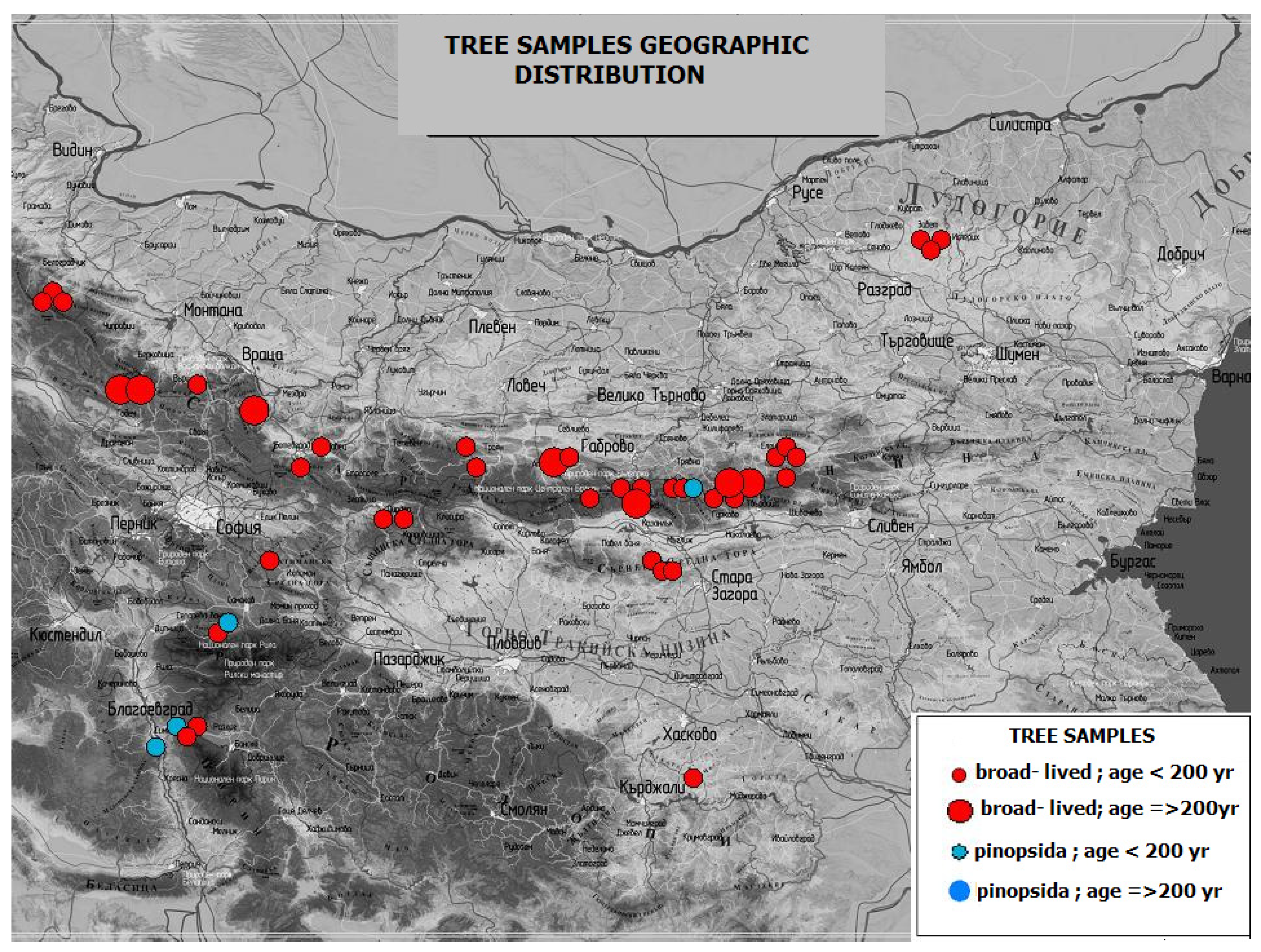
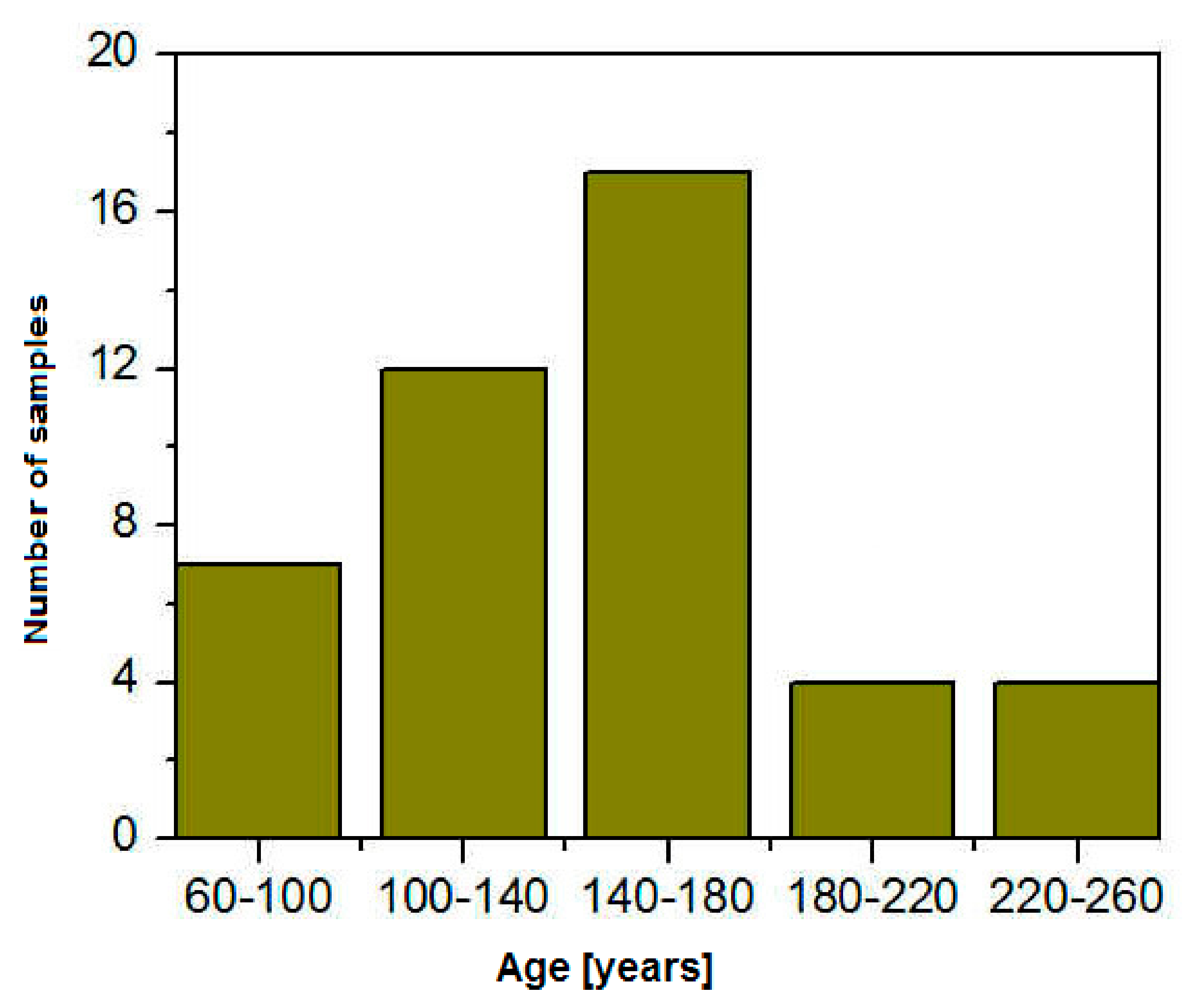
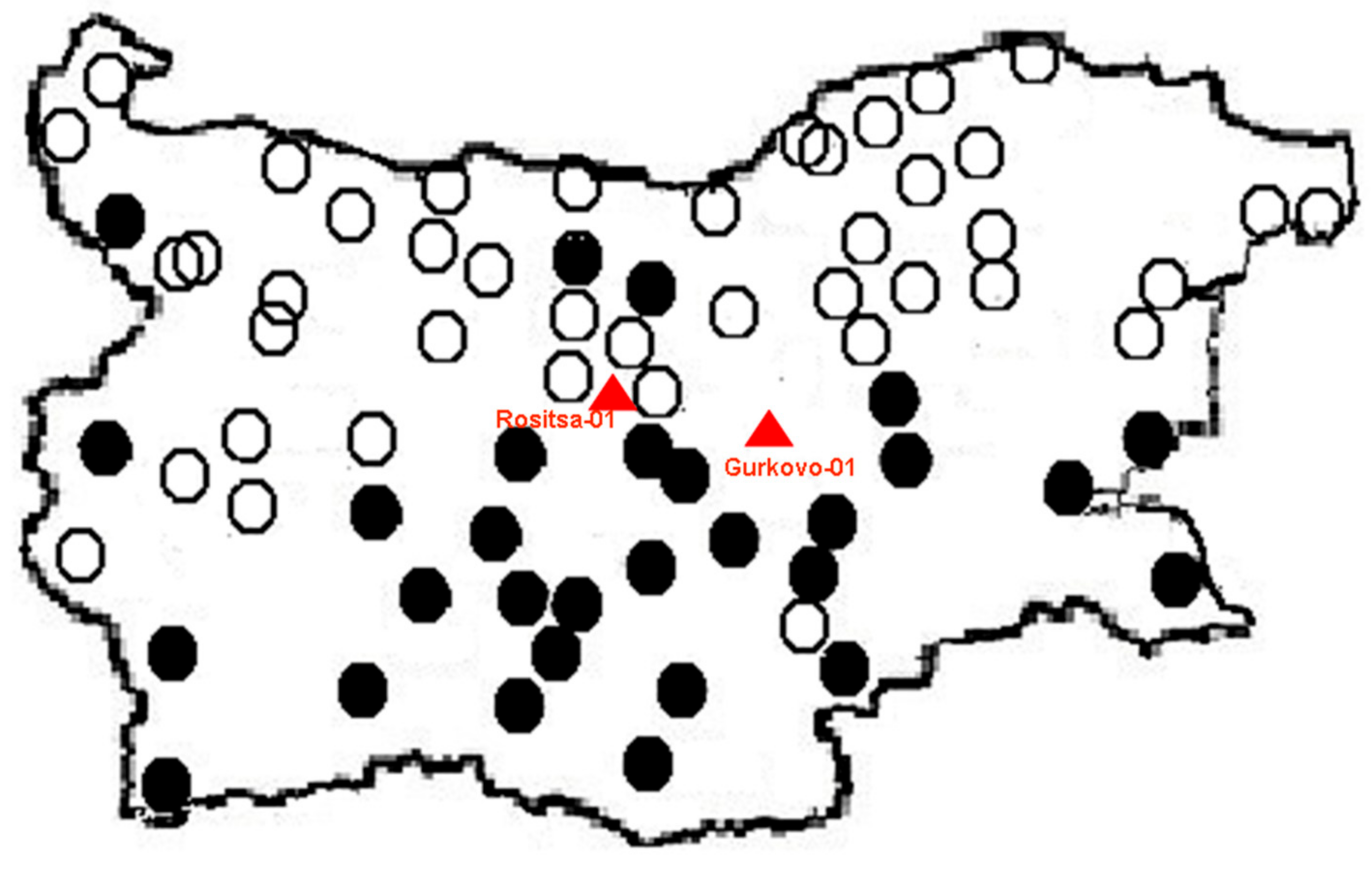




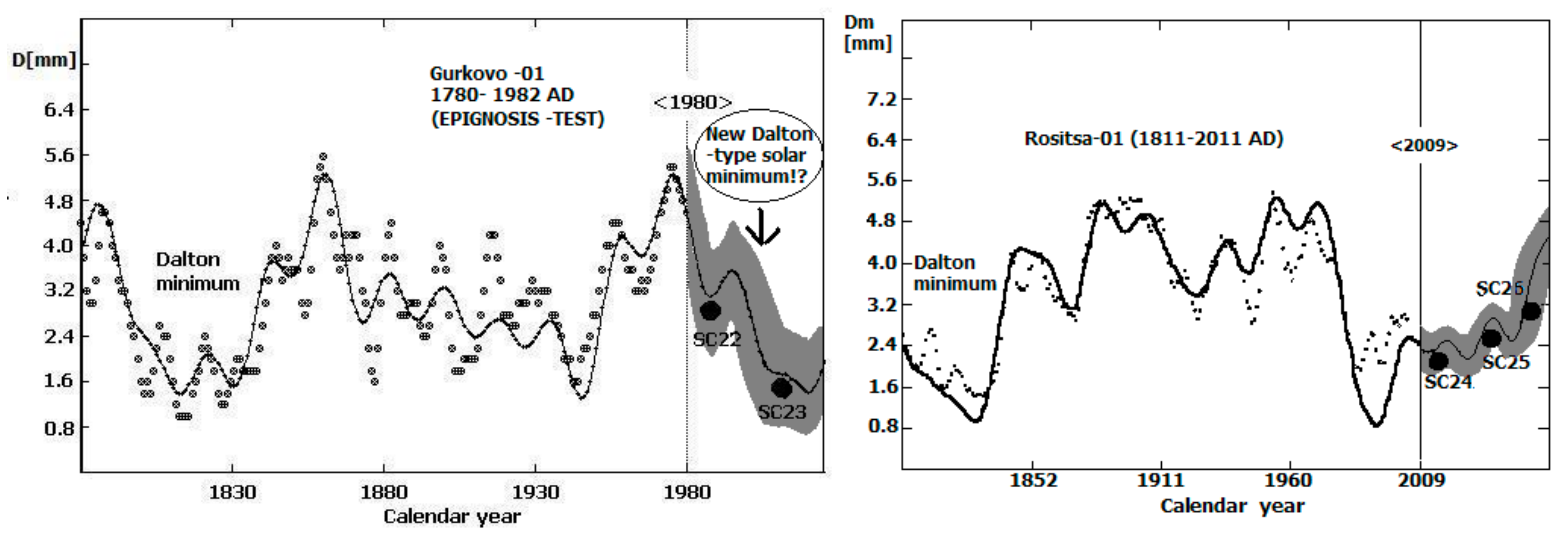
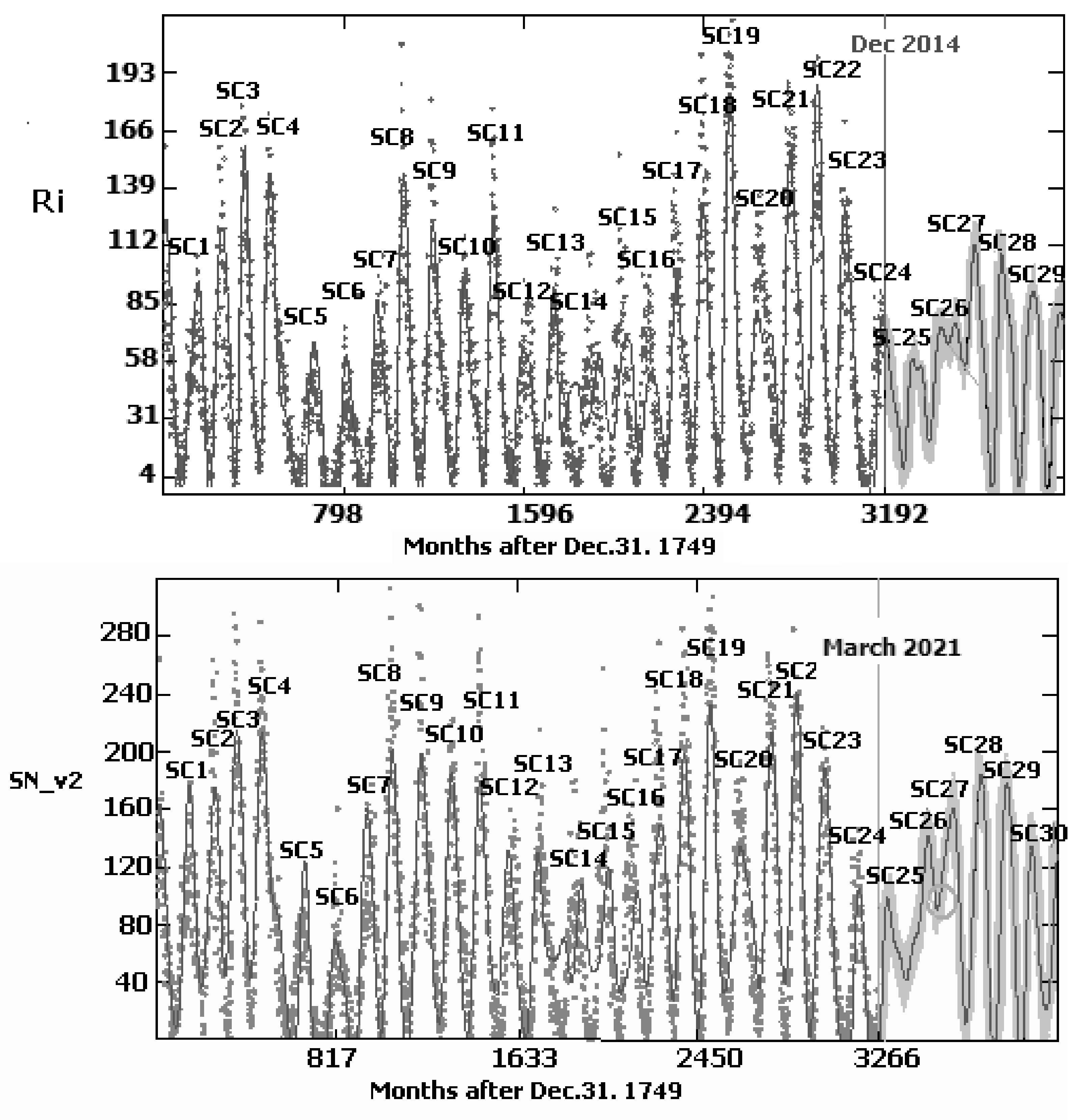
Publisher’s Note: MDPI stays neutral with regard to jurisdictional claims in published maps and institutional affiliations. |
© 2021 by the author. Licensee MDPI, Basel, Switzerland. This article is an open access article distributed under the terms and conditions of the Creative Commons Attribution (CC BY) license (https://creativecommons.org/licenses/by/4.0/).
Share and Cite
Komitov, B. The European Beech Annual Tree Ring Widths Time Series, Solar–Climatic Relationships and Solar Dynamo Regime Changes. Atmosphere 2021, 12, 829. https://doi.org/10.3390/atmos12070829
Komitov B. The European Beech Annual Tree Ring Widths Time Series, Solar–Climatic Relationships and Solar Dynamo Regime Changes. Atmosphere. 2021; 12(7):829. https://doi.org/10.3390/atmos12070829
Chicago/Turabian StyleKomitov, Boris. 2021. "The European Beech Annual Tree Ring Widths Time Series, Solar–Climatic Relationships and Solar Dynamo Regime Changes" Atmosphere 12, no. 7: 829. https://doi.org/10.3390/atmos12070829
APA StyleKomitov, B. (2021). The European Beech Annual Tree Ring Widths Time Series, Solar–Climatic Relationships and Solar Dynamo Regime Changes. Atmosphere, 12(7), 829. https://doi.org/10.3390/atmos12070829




